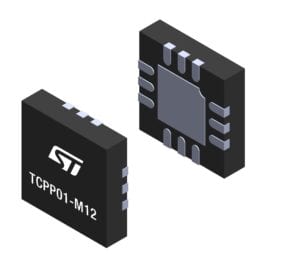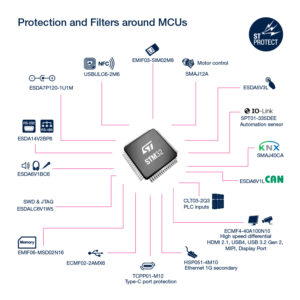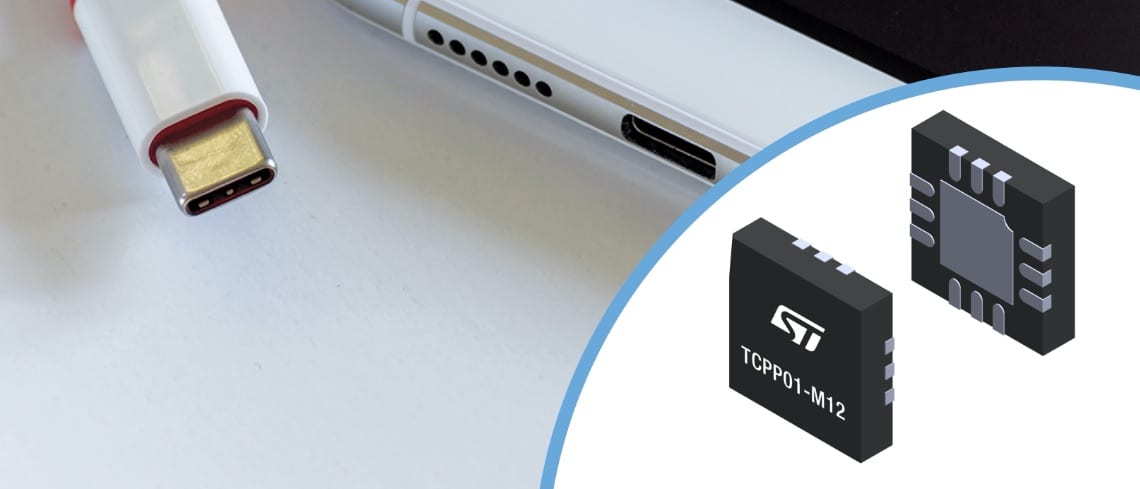The TCPP01-M12 protects USB Type-CTM ports in sink mode (charging) against overvoltage of up to 24 V on VBUS, 6 V on CC lines, and against electrostatic discharges on the connector pins, among other things. TCPP stands for Type-C Port Protection, and the TCPP01-M12 works as a companion chip for our STM32 MCUs with built-in USB-C Power Delivery (UCPD). Hence, using an STM32G0, STM32G4, STM32L5, or STM32U5, and the TCPP01-M12 is significantly more cost-effective than a bundle of external devices. The TCPP01-M12 also distinguishes itself thanks to a null quiescent current when nothing is connected to the port.
TCPP01-M12: Protecting the Popularity of USB-C
The Rise of USB-C

The press1 hailed 2019 as the year when USB-C reached critical adoption. Since then, the connector has permeated so many aspects of the tech industry that it’s even on our latest STLINK-V3MINIE. ST Debugging probes only use well-established technologies to reach the largest crowds and enjoy greater reliability. The presence of USB-C is thus highly symbolic. Moreover, the European Union is strongly signaling the arrival of a common USB-C charger mandate. As a result, companies will have to integrate the port into their product. And while the exact scope isn’t yet clear, the latest Internal Market and Consumer Protection Committee session on the matter recommended widening the type of products that would fall under this regulation.
The New Challenges That Come With USB-C
The adoption of USB-C is bringing a new set of challenges. Poor quality chargers that don’t correctly control their voltage are increasingly common. Consequently, if a sink device (charging) requests only 5 V, but a poorly made source product (charger) remains at 20 V due to hardware or software defects, receiving the charge without adequate protection can severely damage the VBUS line. Engineers must also guard against electrostatic discharges or electrical over-stresses. Since the USB Type-C connector is so small, it’s essential to protect it against a short between the CC and VBUS lines, which would damage the USB controller.
The EU initiatives around USB-C also impact designs, even if there are no regulations yet. Many companies are even adopting the port despite using very traditional power profiles. Indeed, many modern USB-C products benefit from USB Power Delivery, which can handle up to 48 V and 5 A in its 3.1 Revision. However, designs will use USB-C in a 5 V and 3 A legacy mode in many instances. There’s no need for a power delivery controller in such a configuration since the power profile only necessitates a pull-down resistor. However, the same devices need protection as they might operate with products that may send a lot more power. Hence, even legacy mode needs sturdy protection.
TCPP01-M12: Enabling the Protection of USB-C
A More Cost-Effective USB-C Protection

Until now, protection circuits were inside the USB-C Power Delivery controller. However, by embedding the module in an MCU and offering a companion Type-C port protection, we lowered the bill of material. We also facilitated the transition from micro-B devices since an expensive USB-C PD ASIC controller is no longer required. Indeed, one of the reasons the MCU and TCPP01-M12 bundle is such a compelling financial proposition is that the protection device integrates the VBUS gate driver, enabling the use of more affordable N-MOSFET instead of expensive P-MOSFET. Additionally, TCPP01-M12 is USB-IF certified (Test ID: 5205), meaning that teams that follow ST’s implementation and code example will obtain their certification faster.
A More Efficient USB-C Implementation
Another advantage of using the TCPP01-M12 with a microcontroller that embarks a Power Delivery controller is its flexible architecture. Engineers can separate the low-voltage MCU domain and high-voltage power path and benefit from the protections needed. Additionally, the QFN12 package of the TCPP01-M12 can sit really close to the USB Type-C connector to maximize protection. The device’s support for programmable power supplies (PPS) also means that the sink device starts at 3.3. V and increases its request voltage by 20 mV increments until it matches the characteristics of the battery, thus offering quick charging capabilities while safeguarding the system.
TCPP01-M12 has a positive impact on the overall efficiency, compared to competing solutions, by offering a low RDSon and a null quiescent current. The last feature is possible because the device receives power from the GPIO pin of the MCU rather than an internal low-dropout regulator. As a result, when the user unplugs a cable, the TCPP01-M12 doesn’t consume any energy at all. This is particularly crucial for companies looking to create tiny products with small batteries. Many engineers may underestimate it, but every microamp counts when a product is as little as a pen.
Getting Started With the X-NUCLEO-SNK1M1
Until now, the USB-C PD standard was extremely demanding. Engineers had to review half a thousand pages to understand the protocol, and teams had to do almost everything from scratch. However, ST will now include the TCPP01-M12 on all its new development boards with a USB-C port, and designers can get our schematics to reuse them in their design. We are also inaugurating the X-NUCLEO-SNK1M1, a 64-pin Nucleo expansion board featuring the TCPP01-M12 and a load switch that enables the creation of a sink PPS USB-C Power Delivery application of up to 100 W when associated with the NUCLEO-G071RB or the NUCLEO-G474RE development boards.
Engineers can also use the expansion board with microcontrollers that don’t house a USB Power Delivery controller to mimic a legacy application. The TCPP01-M12 is present on the NUCLEO-L552ZE-Q and the NUCLEO-U575ZI-Q. The protection device uses a QFN12 package with a 500 µm pitch, which remains more common for PCB assembly and thus more accessible. We even offer an application noteand a getting started guide for engineers looking to build a prototype with our Nucleo boards, STM32CubeMX, and STM32CubeMonUCPD. ST also provides the X-CUBE-TCPP, which contains middleware and example code.




